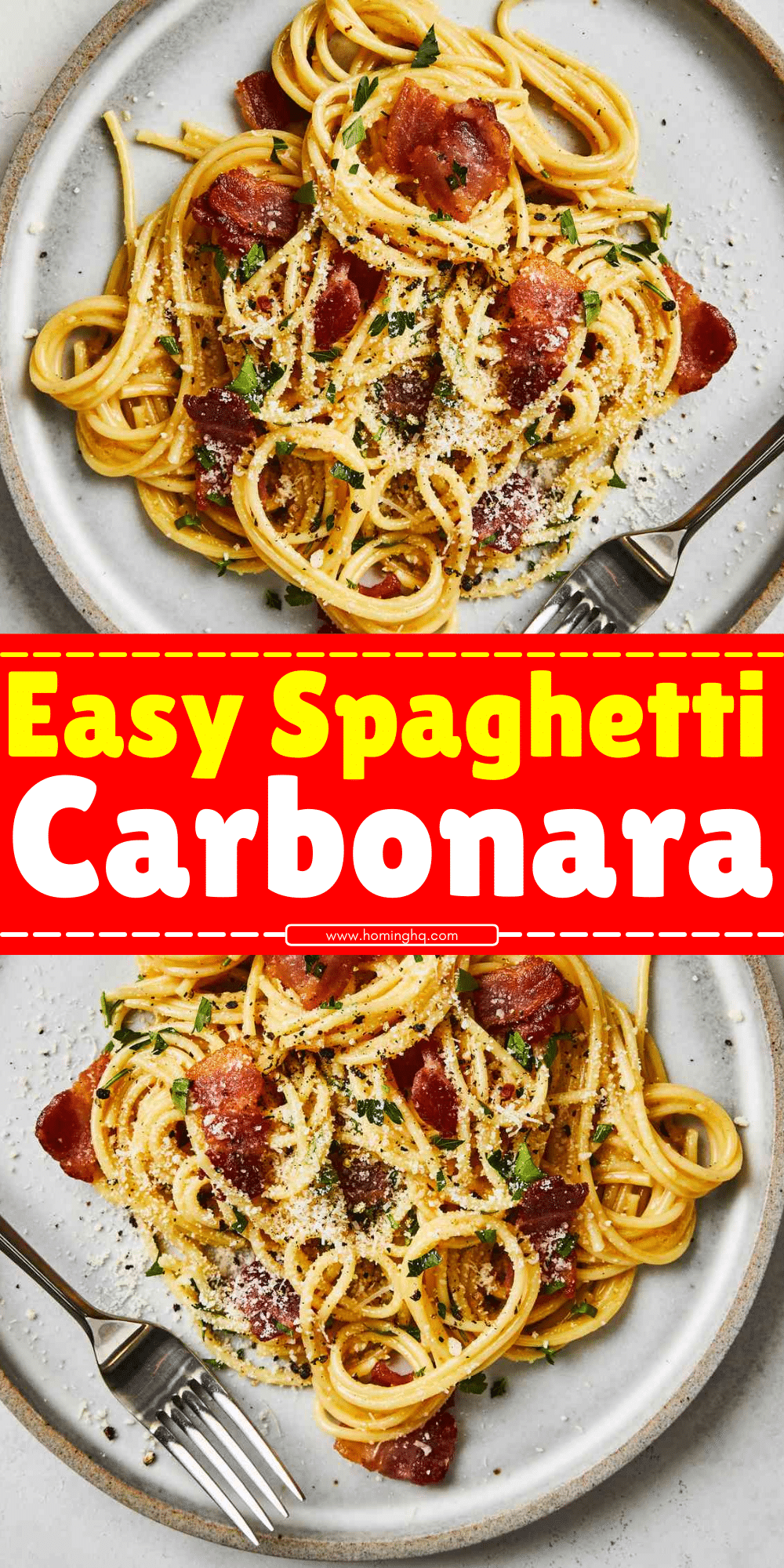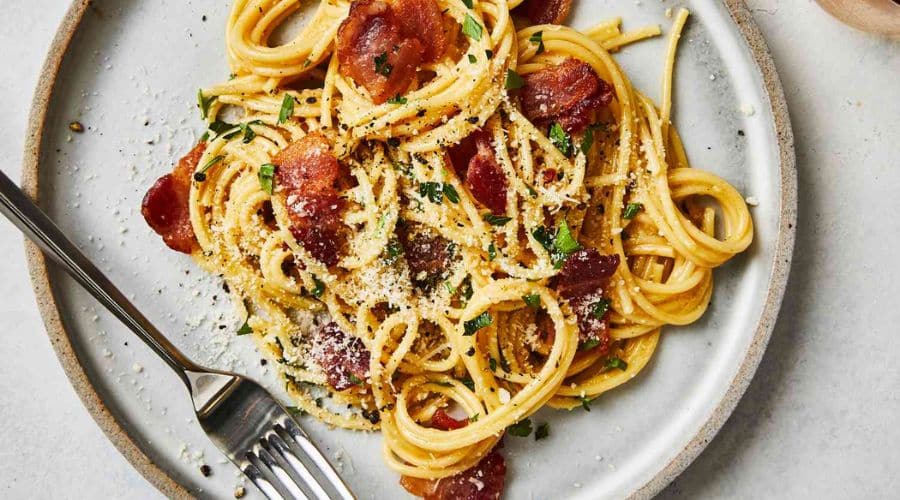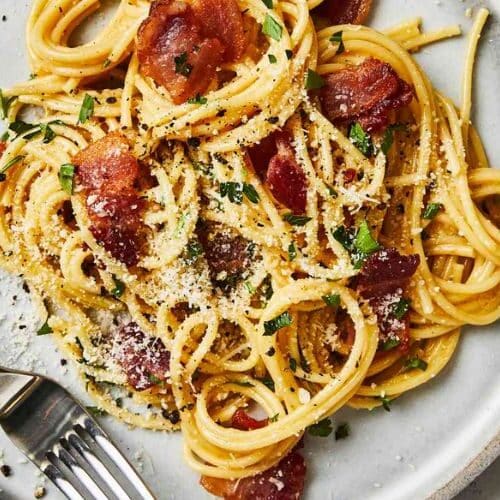All products are selected by our editorial team for quality. If you buy through our links, we may earn a small commission at no extra cost to you.
Spaghetti Carbonara is a beloved Italian classic known for its rich and creamy texture—without any cream!
Originating from Rome, this iconic pasta dish is made with a few simple ingredients that come together to create a mouthwatering flavor.
The combination of crisp guanciale, fresh eggs, Pecorino Romano cheese, and freshly cracked black pepper creates the perfect balance of savory and creamy, making it a favorite comfort food for many.
Whether you’re new to making pasta or an experienced cook, Spaghetti Carbonara is a dish that’s surprisingly easy to prepare.
It’s all about technique—using the heat of the pasta to gently cook the eggs into a smooth sauce.
So, if you’ve been craving the ultimate Italian dish that’s fast, flavorful, and oh-so-satisfying, then look no further!

Ingredients You’ll Need for Spaghetti Carbonara
To make an authentic Spaghetti Carbonara, you don’t need much—just a handful of key ingredients that bring out incredible flavor. Here’s everything you’ll need:
Spaghetti
While spaghetti is the traditional choice, you can use other long pastas like fettuccine or rigatoni if you prefer.
The pasta should be cooked al dente to hold up well with the sauce.
Guanciale
This is a cured pork product from the cheek or jowl of a pig. It’s the key to achieving the authentic flavor of Carbonara.
Guanciale has a rich, slightly sweet taste that distinguishes it from pancetta or bacon, though those can be used as substitutes if necessary.
Eggs
The richness of Carbonara comes from the egg yolks. They create the creamy texture of the sauce, so make sure you use fresh, high-quality eggs.
The egg whites are not needed in this dish.
Pecorino Romano Cheese
This sharp, salty cheese adds the perfect amount of tang to the Carbonara sauce.
Grate it finely for a smoother consistency when mixing with the eggs.
Freshly Ground Black Pepper
Pepper is an essential seasoning in Carbonara. It gives the dish that signature kick and enhances the richness of the egg and cheese sauce.
Salt
Used in both the pasta water and for seasoning the final dish. Be careful with the salt in the pasta water since the guanciale and Pecorino are already quite salty.
How to Make Spaghetti Carbonara: Step-by-Step

Making Spaghetti Carbonara requires a bit of technique, but it’s fairly simple to master once you know the steps. Here’s how to make this classic dish:
Step 1: Prepare Your Ingredients
Start by dicing the guanciale into small pieces. This will allow it to crisp up evenly when cooked.
Grate your Pecorino Romano cheese, and set aside about 1 cup. In a bowl, separate the egg yolks from the whites (you’ll only use the yolks for the sauce).
Step 2: Cook the Pasta
Bring a large pot of salted water to a boil. Add your spaghetti and cook according to the package instructions until al dente (typically 8-9 minutes). Before draining the pasta, reserve about 1 cup of pasta water to use later for the sauce.
Step 3: Cook the Guanciale
While the pasta cooks, heat a large pan over medium heat. Add the diced guanciale and cook until it becomes crispy and golden, about 3-4 minutes.
The guanciale will release its fat, which you’ll use to flavor the pasta. Remove the pan from the heat once it’s done to prevent overcooking.
Step 4: Make the Sauce
In a separate bowl, whisk together the egg yolks, grated Pecorino Romano cheese, and freshly ground black pepper.
Mix until the sauce is smooth and creamy. You can add a tablespoon of the reserved pasta water to thin it out if needed, but keep it thick enough to coat the pasta.
Step 5: Combine the Pasta and Guanciale
Once the pasta is done, transfer it directly from the pot into the pan with the crispy guanciale.
Toss the pasta in the rendered fat to coat it thoroughly. While the pasta is still hot, slowly pour the egg and cheese mixture over it, continuously stirring to avoid scrambling the eggs.
The residual heat from the pasta will cook the eggs just enough to form a silky, creamy sauce.
Step 6: Adjust the Sauce
If the sauce seems too thick, add a little more reserved pasta water, a tablespoon at a time, until you reach the desired consistency.
The sauce should be smooth, creamy, and slightly glossy.
Tips for Perfect Spaghetti Carbonara
To ensure your Spaghetti Carbonara turns out perfect every time, here are a few helpful tips:
Avoid Using Cream
The true magic of Carbonara lies in the simplicity of the ingredients.
Traditional recipes do not use cream—just eggs, cheese, and pasta water for that luscious, creamy texture.
Trust the eggs to give you that richness without the need for added creaminess.
Choose the Right Cheese
Pecorino Romano is the authentic choice for Carbonara. It’s a sheep’s milk cheese that has a sharper, saltier taste than Parmesan, which perfectly complements the savory guanciale.
If you can’t find Pecorino, Parmigiano Reggiano can be a substitute, but the flavor will be milder.
Use the Right Pasta Water
Pasta water is your secret weapon. The starch in the water helps bind the sauce together, making it velvety and smooth.
Always reserve some pasta water before draining your pasta, as you may need it to adjust the sauce later.
Be Gentle with Heat
When combining the egg mixture with the pasta, ensure the pan isn’t too hot.
The residual heat from the pasta is enough to gently cook the eggs into a creamy sauce.
If the heat is too high, the eggs will scramble, and you’ll lose that smooth texture.
Perfect the Guanciale
Guanciale can sometimes be hard to find, but it’s worth tracking down for its unique flavor.
When cooking it, make sure to render out the fat slowly, allowing the guanciale to crisp up without burning.
This will give your Carbonara the perfect texture and depth of flavor.
Common Mistakes to Avoid
While Spaghetti Carbonara is a simple dish, there are a few common mistakes that can prevent you from achieving that perfect, creamy texture. Here’s what to watch out for:
1. Overcooking the Eggs
The most critical part of making Carbonara is avoiding scrambled eggs.
To get that smooth, creamy sauce, the heat from the pasta should cook the eggs just enough without turning them into a scramble.
Always remove the pan from the heat before adding the egg mixture, and stir quickly to prevent the eggs from cooking too fast.
2. Using Cream
It’s tempting to add cream to make the sauce extra rich, but traditional Carbonara does not include cream.
The creaminess should come from the eggs and Pecorino Romano cheese.
Using cream will alter the flavor and texture, so stick with the classic method for the best results.
3. Not Using Enough Pasta Water
Pasta water is essential for achieving the silky texture of Carbonara. It helps emulsify the sauce and ensures it coats the pasta smoothly.
Always reserve a bit of pasta water before draining, and don’t hesitate to add it gradually as you mix the eggs and cheese into the pasta.
4. Using the Wrong Type of Pork
Guanciale is the traditional choice for Carbonara, and it makes a big difference in the flavor.
If you use bacon or pancetta as a substitute, the dish will still be tasty, but it won’t have the authentic taste that comes from guanciale.
If possible, try to find guanciale for the best results.
5. Not Seasoning Properly
Carbonara relies on the balance of salty, savory flavors. Guanciale and Pecorino Romano are already quite salty, so be careful not to over-salt the pasta water.
You can always adjust the seasoning with freshly ground black pepper, which is another key ingredient in bringing out the dish’s full flavor.
Serving Suggestions for Spaghetti Carbonara
Spaghetti Carbonara is a dish that shines on its own, but pairing it with the right sides can elevate the meal even further.
Here are a few serving suggestions:
1. Simple Green Salad
A fresh, crisp green salad is the perfect complement to the rich and creamy Carbonara.
Consider a mix of arugula, spinach, or even a classic Caesar salad to balance the richness of the pasta.
A light vinaigrette with lemon or balsamic vinegar can add a refreshing contrast.
2. Crusty Bread
Serve the dish with a slice of warm, crusty bread to soak up any extra sauce.
A freshly baked baguette or sourdough bread works wonderfully with Carbonara, allowing you to savor every last bit of the creamy goodness.
3. Wine Pairing
Pair your Spaghetti Carbonara with a glass of dry white wine to enhance the flavors.
A crisp Pinot Grigio, Sauvignon Blanc, or even a light Chardonnay will complement the richness of the dish without overwhelming it.
For those who prefer red wine, a light, fruity red like Pinot Noir works as well.
4. Roasted Vegetables
Roasted vegetables like Brussels sprouts, asparagus, or zucchini can provide a great contrast to the richness of the pasta.
The caramelized flavors of roasted veggies also add depth to the overall meal.
5. A Sprinkle of Extra Pecorino Romano
For those who love a little extra cheese, a light dusting of Pecorino Romano or Parmesan can be added just before serving.
It’ll provide an extra hit of flavor and richness, making your dish even more indulgent.
Conclusion
Spaghetti Carbonara is the epitome of Italian comfort food—simple, rich, and full of flavor.
With just a handful of ingredients, you can create a dish that feels indulgent but is quick enough for a weeknight dinner.
The balance of creamy eggs, sharp Pecorino Romano, and crispy guanciale is what makes this pasta so unforgettable.
By following the steps and tips provided, you’ll be able to make a perfect Carbonara every time.
Whether you’re cooking for yourself, a loved one, or a group, this classic Italian dish is sure to impress.
So, grab your ingredients, channel your inner Italian chef, and enjoy the creamy, savory goodness of Spaghetti Carbonara!
Frequently Asked Questions (FAQ)
1. Can I make Spaghetti Carbonara ahead of time?
Spaghetti Carbonara is best served fresh, as the creamy sauce tends to thicken and lose its silky texture when reheated.
However, if you need to make it ahead of time, you can prepare the components separately (pasta, guanciale, egg mixture) and then combine them just before serving.
2. Can I use bacon instead of guanciale?
Yes, bacon can be used as a substitute for guanciale. However, guanciale offers a more delicate, slightly sweet flavor, while bacon is smokier and saltier.
If possible, try to find guanciale for the most authentic taste, but bacon will still make a delicious dish.
3. What can I substitute for Pecorino Romano?
While Pecorino Romano is the traditional cheese for Carbonara, you can substitute it with Parmigiano Reggiano for a milder, less salty flavor.
However, the sharpness of Pecorino is key to the authentic flavor, so use it if you can.
4. Can I make Carbonara with whole eggs instead of just yolks?
Traditional Carbonara recipes only use egg yolks for their richness and creaminess.
Whole eggs can be used as a substitute, but the sauce may not be as silky.
If you want to use whole eggs, consider using two whole eggs and one additional yolk for the best results.
5. How can I make Spaghetti Carbonara spicier?
If you like your Carbonara with a little extra heat, you can add red pepper flakes along with the black pepper when mixing the egg sauce.
A pinch of chili flakes will add a subtle heat that complements the dish without overpowering it.

Spaghetti Carbonara
Equipment
- Large Pot: (for boiling pasta)
- Large Pan or Skillet: (for cooking guanciale and mixing pasta with egg mixture)
- Whisk: (for mixing egg yolks and cheese)
- Grater: (for grating Pecorino Romano)
- Strainer/Colander: (for draining pasta)
- Tongs or Pasta Spoon: (for tossing pasta in the sauce)
Ingredients
- 400 g 14oz Spaghetti
- 150 g 5.3oz Guanciale (or pancetta/bacon as a substitute)
- 4 large Egg Yolks discard whites
- 1 cup 100g Pecorino Romano Cheese (finely grated)
- Freshly Ground Black Pepper to taste
- Salt for pasta water
- 1 cup reserved Pasta Water
Instructions
Prepare the Ingredients:
- Dice the guanciale into small pieces. Grate the Pecorino Romano and set aside. Separate the egg yolks from the whites (you will only use the yolks).
Cook the Pasta:
- Bring a large pot of salted water to a boil. Add the spaghetti and cook until al dente (usually 8-9 minutes). Before draining, reserve 1 cup of pasta water for the sauce.
Cook the Guanciale:
- In a large pan, heat over medium heat. Add the diced guanciale and cook until crispy and golden, about 4-5 minutes. Remove the pan from heat to avoid burning the guanciale.
Make the Egg Sauce:
- In a separate bowl, whisk together the egg yolks, grated Pecorino Romano, and freshly ground black pepper until smooth and creamy. Add a tablespoon of the reserved pasta water to thin it out if necessary.
Combine Pasta and Guanciale:
- Add the drained pasta to the pan with the cooked guanciale, tossing to coat the pasta in the rendered fat. Slowly pour in the egg and cheese mixture, stirring quickly to create a creamy sauce. The heat from the pasta will gently cook the eggs into a velvety sauce.
Adjust the Sauce:
- If the sauce appears too thick, add more reserved pasta water, one tablespoon at a time, until the desired consistency is reached.
Serve:
- Plate the pasta and finish with an extra sprinkle of Pecorino Romano and a few cracks of black pepper. Serve immediately and enjoy!
Notes
- Guanciale is the traditional choice for this dish, but if unavailable, pancetta or even bacon can work as substitutes. However, guanciale offers a more delicate and authentic flavor.
- Eggs should be fresh, as they are the base of the creamy sauce. Only use egg yolks for the best texture.
- Pasta Water is key to the sauce’s consistency. Be sure to reserve some before draining the pasta.
- Seasoning: The dish already contains a lot of salt from the guanciale and Pecorino Romano, so be cautious when salting the pasta water.
- This recipe is best served immediately, as the sauce tends to thicken if left to sit.

